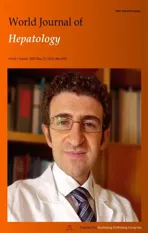Role of biliary complications in chronic graft rejection after living donor liver transplantation
2022-11-28AimanObedAbdallaBashirAnwarJarradLaszloFuzesi
Aiman Obed,Abdalla Bashir,Anwar Jarrad,Laszlo Fuzesi
Aiman Obed,Hepatobiliary and Liver Transplant Unit,Jordan Hospital,Amman 52112,Jordan
Abdalla Βashir,Department of General Surgery,Jordan Hospital,Amman 52112,Jordan
Anwar Jarrad,Department of Hepatology,Jordan Hospital,Amman 52112,Jordan
Laszlo Fuzesi,Department of Pathology,Faculty of Medicine,University Augsburg,Augsburg 86156,Germany
Abstract Postoperative biliary complications remain a substantial challenge after living donor liver transplantation,especially due to its heterogeneous clinical presentation.
Key Words: Chronic graft rejection;Biliary complications;Living donor liver transplantation;Graft survival;Cholangiopathy
TO THE EDlTOR
With great interest,we read the article by Guirguiset al[1]entitled “Biliary complications in recipients of living donor liver transplantation: A single-center study”.The study presents the findings on 169 recipients of right-lobe living-donor liver transplantation,which were followed for at least 1 year,or until graft or patient loss occurred.Based on their data on biliary leakage,biliary infection,and biliary stricture,as well as the presence of chronic graft rejection(CGR)and failure,the authors conclude that biliary infection/complications are an independent risk factor for CGR and graft failure in their study population.
While we congratulate the team on its attempt to unravel the impact of biliary complications on graft survival and mortality,we believe that some conclusions drawn in the article must be critically addressed.
First,the authors reference a study on a pediatric study population and deduce that biliary infection is a risk factor for CGR.However,in the mentioned study by Tannuriet al[2],the authors merely conclude that the occurrence of ductopenia is linked to a poor prognosis in pediatric patients with CGR.Furthermore,the authors outline main pathological changes that indicate CGR,such as vanishing bile duct syndrome and obliterative arteriopathy.Hence,Tannuriet alinterpret ductopenia as the result of CGR,not its cause.
On that note,we want to turn the attention to well-defined classifications of CGR,especially in liver grafts for children and adults,respectively.In the updatedInternational Banff Schema for Liver Allograft Rejection,Demetriset al[3]describe the features of CGR in accordance to histopathological findings of explanted liver tissue.Hereby,leading indicators of advanced CGR are outlined.These include,amongst others,loss of bile ducts(BD)of more than half of portal tracts,as well as the discovery of a foam cell obliterative arteriopathy in rejected tissue.Meanwhile,the loss of BD in less than 50% of portal tracts,BD degeneration,perisinusoidal fibrosis,and inflammation are considered preliminary findings for CGR after liver transplantation.
Second,in their retrospective multivariate analysis,Horsteret al[4]reported on their 12-year experience with 352 liver transplant recipients.They identified HCV serostatus and high peritransplantation viral serum loads as independent risk factors for postoperative anastomotic strictures.While non-anastomotic strictures,the presence of bile leaks,and subsequent treatment interventions worsened graft outcome in all patients,no increase of CGR was detected.Notably,biliary complications and HCV serum positivity exerted additive effects,although individually they did not alter the risk for graft loss.However,HCV-positive patients with BCs displayed significantly worse graft outcomes.The authors did not conclude that biliary infections would lead to CGR.
Although we understand that distinguishing between CGR and other causes of post-transplant cholangiopathy(PTC)might be histologically challenging and clinically difficult,it is of great significance to characterize the underlying etiology in order to provide our patients with the best available treatment and procedures.Thus,we appreciate CGR as one possible cause of the posttransplant cholangiopathy.
Leading to increased patient morbidity and mortality after liver transplantation,these entities require highly experienced physicians for a clear distinction and prompt intervention.The term PTC encompasses a wide range of histological donor bile duct aberrations,including biliary stricture,cast formation to full thickness and,even,bile duct necrosis with intrahepatic biloma development.As per definition,the presence of thrombosis,severe stenosis of the hepatic artery,or underlying chronic autoimmune disease(i.e.,primary sclerosing cholangitis)is excluded from the definition of PTC[5].We conclude that other causes of PTC can be mistaken for suspected chronic graft failure with assumed biliary etiology.Thus,additional measures should be taken to prevent misdiagnosis in this highly susceptible patient collectives.
In essence,we are delighted to see the efforts at Ain Shams University,Egypt to better understand clinical observations on biliary complications after right lobe living donor liver transplantation,in order to sustainably achieve better patient outcomes.Nevertheless,the cases of biliary-based CGR should be validated by carefully distinguishing this uncommon condition from multifocal biliary pathologies of other etiologies.Adequately powered,prospective study designs with larger study populations could effectively contribute to a better understanding and improved therapy options.
FOOTNOTES
Author contributions:Obed A designed the research;Obed A,Füzesi L,and Jarrad A performed research and revised the letter;Bashir A and Obed A analyzed the data;Obed A and Bashir A wrote the letter.
Conflict-of-interest statement:The authors declare no funding or conflicts of interest for this article.
Open-Access:This article is an open-access article that was selected by an in-house editor and fully peer-reviewed by external reviewers.It is distributed in accordance with the Creative Commons Attribution NonCommercial(CC BYNC 4.0)license,which permits others to distribute,remix,adapt,build upon this work non-commercially,and license their derivative works on different terms,provided the original work is properly cited and the use is noncommercial.See: https://creativecommons.org/Licenses/by-nc/4.0/
Country/Territory of origin:United States
ORClD number:Aiman Obed 0000-0001-7519-9868;Abdalla Bashir 0000-0001-7128-1979;Anwar Jarrad 0000-0001-8749-8160;Laszlo Fuzesi 0000-0002-9943-636X.
S-Editor:Wang LL
L-Editor:Wang TQ
P-Editor:Wang LL
杂志排行
World Journal of Hepatology的其它文章
- Reply to "Six-minute walking test performance is associated with survival in cirrhotic patients" to the editor
- Role of hepatitis Β virus in development of hepatocellular carcinoma:Focus on covalently closed circular DNA
- Emerging curative-intent minimally-invasive therapies for hepatocellular carcinoma
- Saving time and effort: Βest practice for adapting existing patientreported outcome measures in hepatology
- Loco-regional treatment of hepatocellular carcinoma:Role of contrast-enhanced ultrasonography
- Βenign focal liver lesions:The role of magnetic resonance imaging
